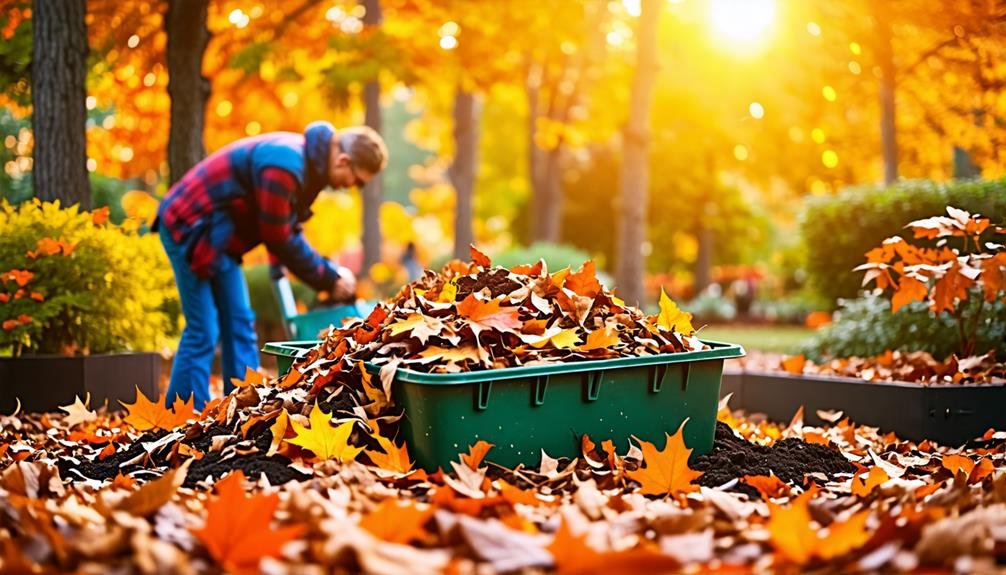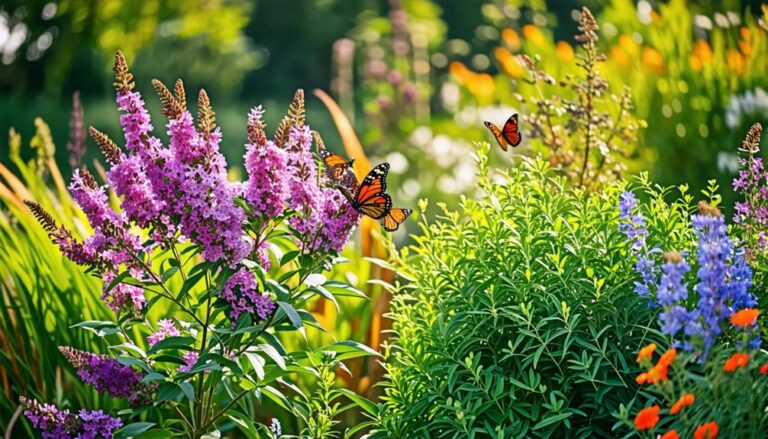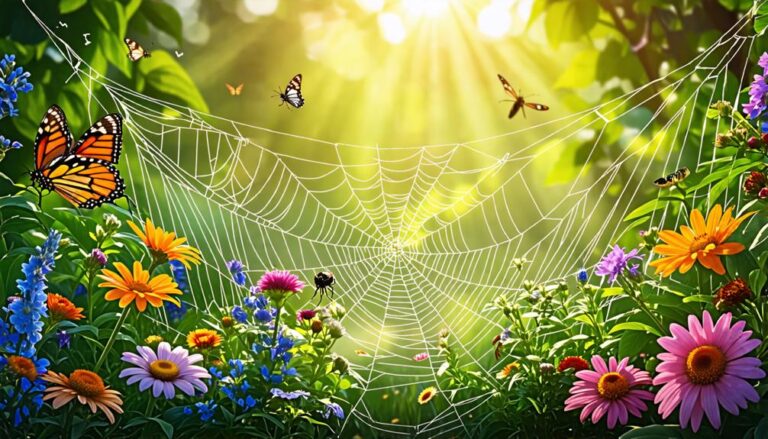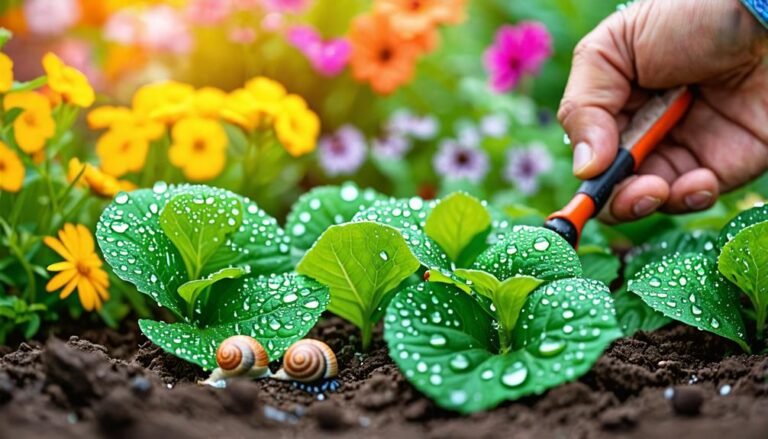Transforming autumn foliage into garden fuel is straightforward and advantageous. Begin by shredding leaves with a leaf shredder or lawn mower; this prevents clumping and accelerates decomposition. Shredded leaves can serve as nutrient-rich compost, enriching your soil and retaining moisture for plants. Be cautious, however, as some tree species may release chemicals harmful to certain plants. For optimal results, blend shredded leaves with other organic materials and monitor soil moisture levels. In general, this eco-friendly approach not only minimizes waste but also fosters a healthier garden ecosystem. There's much more to uncover about this effective practice.
Shredding Leaves for Decomposition
Shredding leaves promotes efficient decomposition by preventing clumping and accelerating breakdown. When leaves are shredded, smaller pieces provide more surface area, allowing microorganisms to decompose them effectively. This process is essential for composting leaves, aiming to transform organic matter into nutrient-rich compost for gardens.
Using a leaf shredder or a Toro lawn mower equipped with a mulching blade simplifies this task. Once shredded, leaves can be raked into a pile or spread directly as mulch over garden beds. Shredded leaves not only act as natural mulch but also insulate the soil, protecting it from extreme temperatures.
As they decompose over winter, shredded leaves enrich the soil with essential nutrients, fostering healthy plant growth in spring. Incorporating this practice into gardening routines enhances garden health and reduces waste, utilizing nature's resources for the benefit of both gardens and the environment.
Considerations Before Using Leaves
Before you start using leaves in your garden, it's crucial to take into account a few factors. Certain tree species, like walnut and eucalyptus, can release chemicals that may harm your plants, so it's best to avoid their leaves. Moreover, some plants, such as sage and lavender, may not thrive when covered with leaf mulch, so be sure to check your garden's specific needs before applying shredded leaves.
Toxic Leaf Species
Incorporating foliage into your garden requires caution. Toxic tree species, like walnut, eucalyptus, and camphor laurel, contain chemicals that can harm plant growth and beneficial soil organisms. This consideration is essential during autumn gardening, aiming to create a thriving ecosystem for future plantings.
Utilizing non-toxic autumn leaves enhances your garden's vibrancy and nutrient density. Shredded leaves act as excellent compost material, enriching the soil as they break down. However, knowing the leaf species you collect is critical. For instance, maple and oak leaves are generally safe and beneficial, while the toxic varieties can hinder growth.
To improve your garden's health, familiarize yourself with the types of foliage you gather. This understanding empowers you to make informed decisions, fostering a flourishing environment for your plants. By choosing only safe leaves, you can enhance your garden confidently while enjoying the splendor of autumn.
Plant Preferences
Understanding plant preferences is essential for effective leaf mulching. Certain species may not benefit from a cover of leaf debris. For example, Mediterranean herbs such as sage, thyme, and oregano thrive in well-drained soil. These herbs require direct sunlight and air circulation, which can be obstructed by thick layers of leaves.
Succulents, which store moisture in their leaves, can suffer from rot if the mulch retains too much moisture. A thin layer of shredded leaves around these plants is ideal, allowing them to absorb nutrients without hindering their growth.
On the other hand, many flowering plants and vegetables benefit significantly from leaf mulch. It enriches the soil with nutrients and retains moisture. By adjusting your mulching methods to meet the specific needs of each plant, you can foster a healthy garden ecosystem. Take the time to assess the requirements of your plants, and enjoy nurturing a vibrant garden while responsibly utilizing fallen leaves.
Benefits of Leaf Garden Fuel

Utilizing leaf garden fuel enhances soil vitality and encourages eco-friendly gardening methods. Decomposing leaves release vital nutrients into the earth, boosting fertility. This natural cycle supports plant growth by supplying essential components like nitrogen, phosphorus, and potassium.
Employing shredded leaves as mulch or compost is a straightforward, efficient approach to streamline your gardening tasks. Unlike conventional composting, which can be demanding, converting leaves into garden fuel involves less effort. By integrating shredded leaves, you create an affordable, green fertilizer that fosters robust plant growth.
Additionally, this technique requires no specialized tools or extensive expertise, making it accessible for all gardeners. Simply shred your leaves and distribute them across your garden or lawn. As they decompose, the leaves enhance soil structure, improve water retention, and stimulate beneficial microorganisms. Adopting leaf garden fuel allows you to take charge of your gardening journey while positively impacting the environment.
Environmental Impact of Leaves
The incorporation of leaves in horticulture enhances soil vitality and plays a crucial role in minimizing environmental waste. By repurposing fallen foliage, gardeners can avert significant quantities of organic material from being discarded in landfills, where decomposition occurs without oxygen, releasing detrimental greenhouse gases. When leaves are chopped and integrated into gardens, they naturally decompose, enriching the earth.
This approach fosters biodiversity by nurturing beneficial microbes and earthworms, which flourish in nutrient-dense settings. Additionally, employing leaves as mulch or in composting contributes to carbon sequestration, alleviating the effects of climate change. For instance, a single layer of shredded leaves functions as insulation, regulating soil temperature and moisture, vital for plant wellness.
Furthermore, this technique empowers individuals in gardening, enabling them to manage their ecological impact. By engaging with the natural cycles of their environment, gardeners can develop a vibrant ecosystem while enjoying the fulfillment of positively impacting the planet. Overall, reusing leaves not only enhances gardens but also aligns with the overarching goal of eco-friendly living.
Tips for Effective Leaf Use

To enhance the advantages of utilizing foliage in your garden, consider adopting various methods that bolster soil vitality and facilitate effective nutrient allocation. Begin by shredding the foliage; this action prevents clumping and accelerates decomposition. A leaf shredder from brands like Black+Decker or a lawn mower can efficiently handle this task. After shredding, gather the leaves into a mound and distribute them across your garden as a top layer, offering insulation for your plants during the winter months.
Combine the shredded foliage with other organic materials, such as grass clippings from your local Home Depot or kitchen scraps, to establish a well-rounded nutrient profile for your soil. It's essential to keep an eye on soil moisture levels since an abundance of leaf mulch can result in over-saturation. Rotate the sections of your garden where you apply leaf mulch to guarantee uniform nutrient distribution. Additionally, explore various types of foliage, as certain species may provide unique advantages for your plants.
Creative Uses for Shredded Leaves
Shredded leaves can serve multiple purposes in your garden, offering both practical and environmental benefits. For instance, applying shredded leaves as mulch helps retain moisture in the soil, reduces weed growth, and improves the general health of your plants. Moreover, using them to create pathways or define garden borders adds an attractive, natural element while promoting soil amendment through gradual decomposition.
Mulching for Moisture Retention
Using shredded leaves as a natural mulch enhances soil health and significantly aids in moisture retention in garden beds. When applied over the earth, these organic materials create a protective cover that minimizes evaporation. This is especially beneficial during hot, arid months when plants struggle to access enough water. By incorporating shredded leaves as mulch, you help maintain a consistent moisture level, enabling your plants to flourish.
Moreover, this organic matter decomposes over time, enriching the soil with essential nutrients that bolster plant growth. For instance, a layer of shredded leaves around vegetable crops helps keep roots cool while supplying vital nutrients as the leaves break down.
To effectively utilize shredded leaves, aim for a thickness of about two to three inches. This depth effectively prevents weed growth while still allowing water to seep into the soil. Keep an eye on moisture levels, as excessive mulch can lead to water saturation. By adopting this straightforward, eco-friendly approach, you can nurture a thriving garden that not only showcases your dedication but also fosters a sustainable ecosystem.
Soil Amendment Benefits
Incorporating shredded leaves into garden soil acts as a potent amendment that enhances soil structure, fertility, and overall vitality. Shredded leaves decompose over time, releasing essential nutrients back into the soil, supporting plant growth. This natural process enriches the earth with organic matter, improving moisture retention and fostering a rich ecosystem of beneficial microorganisms.
As the leaves break down, they aerate the soil, creating a crumbly texture that promotes free root growth. This is crucial for vegetables and flowers, as robust roots lead to vibrant, thriving plants. Additionally, shredded leaves aid in carbon replenishment, critical for maintaining nutrient balance in the earth.
Utilizing shredded leaves is not only effective but also budget-friendly. Instead of purchasing fertilizers from brands like Miracle-Gro, you can tap into a natural resource readily available in your yard. By adopting this method, you choose a sustainable approach that reduces waste and cultivates a flourishing garden environment. With each handful of leaves, you nurture the soil and promote a healthier ecosystem, allowing your garden to thrive naturally.
Pathway and Garden Borders
Using shredded leaves as a natural pathway and garden border material enhances your outdoor space's aesthetic appeal while providing functional benefits. This eco-friendly practice creates beautiful, textured walkways that blend seamlessly with your garden.
To create a leaf pathway, spread a thick layer of shredded leaves along the desired path, compacting them to prevent movement. This layer inhibits weed growth and retains soil moisture during dry spells, reducing the need for frequent irrigation. As the leaves decompose, they enrich the soil with essential nutrients, promoting healthy plant growth.
For garden borders, shredded leaves define spaces and add visual interest. They create natural barriers around flower beds or vegetable patches, separating different areas while providing a soft, organic appearance. Over time, the leaves break down, enhancing soil health.
This method not only beautifies your garden but also encourages sustainability by transforming a common waste product into a valuable resource. Embrace this simple yet effective approach to elevate your gardening experience.




